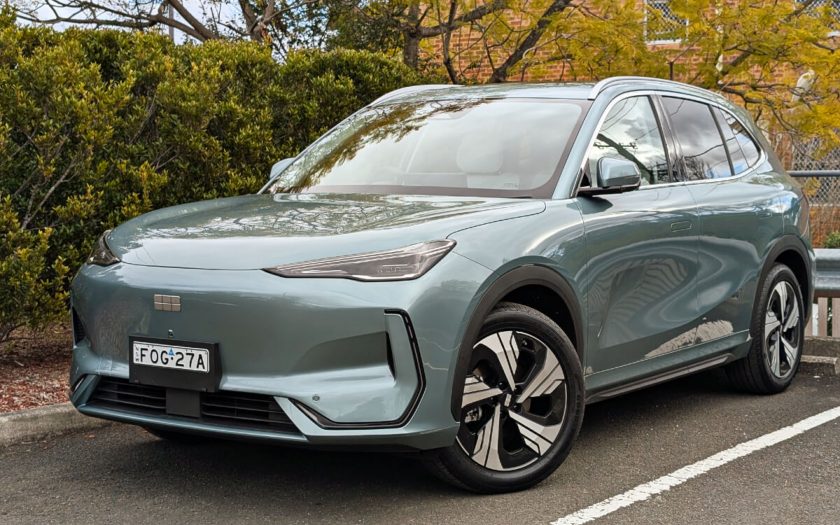Summary: Here’s another tempting EV from China that will win over many buyers. If you decide to buy one, you may want to consider the optional additional cables.
2025 Geely EX5 compact electric crossover SUV
Pricing: $44,990 (Inspire, plus on road costs), $40,990 (Complete, plus on road costs)
Options: any colour other than white $600
Warranty: Seven-years, unlimited kilometre, eight-years battery pack, seven-year roadside assist, two years connected services
Safety: five-star ANCAP (2025)
Engine: single electric motor
Battery: 60.22kWh Lithium-Ion Phosphate
Service intervals: 12 months or 20,000km
Power: 160kW
Torque: 320Nm
Transmission: single-speed, front-wheel drive
Body: 4515mm (long); 1855mm (wide); 1685mm (high)
Build country: China
Kerb weight: 1715kg (Complete), 1765kg (Inspire)
Towing capacity: none
Luggage storage: 410L, 1877L (seats lowered)
Wheels: 18-inch alloy
Tyres: 235/50 18 Goodyear
Spare wheel: puncture repair kit
Ground clearance: 148mm
Turning circle: not stated
Claimed energy consumption: 16.6kWh/100km
Claimed range: 410km
Claimed charging time: 20 minutes (100kW+ DC charger, 30 to 80 percent), 5.7 hours (11kW AC three-phase charging), 25 hours (using supplied cable, Mode 2 fast charging cable $269.50 option)
Energy consumption on test: 15.6kWh/100km (567km)
seniordriveraus consumption on test: not tested
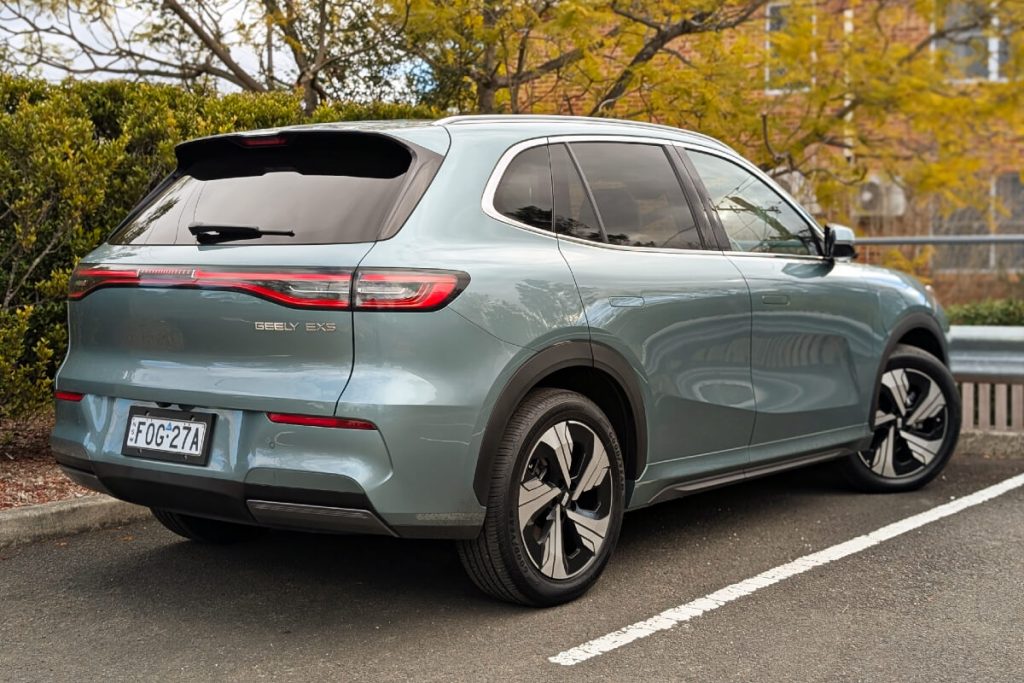
[review]
It’s becoming increasingly difficult to keep track of brands as the Chinese assault on the Australian market continues.
You might have heard the name Geely before, as a WA dealer brought in a few cheap hatches about 15 years ago – Australia’s cheapest car at the time.
This time around however it’s the real deal, although you may not be aware of just how big Geely is – nor the extent of its reach.
Geely not only owns Volvo, Polestar, Proton, Smart and Lotus, it also markets vehicles under its own name as well as the Zeekr and Lynk & Co brands – not to mention its acquisition of US flying car start-up Terrafugia.
Our test vehicle the EX5 is a compact, fully-electric five-seat crossover and, although it’s got some really annoying traits, it’s actually not that bad.
FYI: Proton has also been selling EX5 as one of its own under the moniker e.MAS 7 since December last year.
PS. Geely makes an electric ute too – the Radar (gotta love that name).
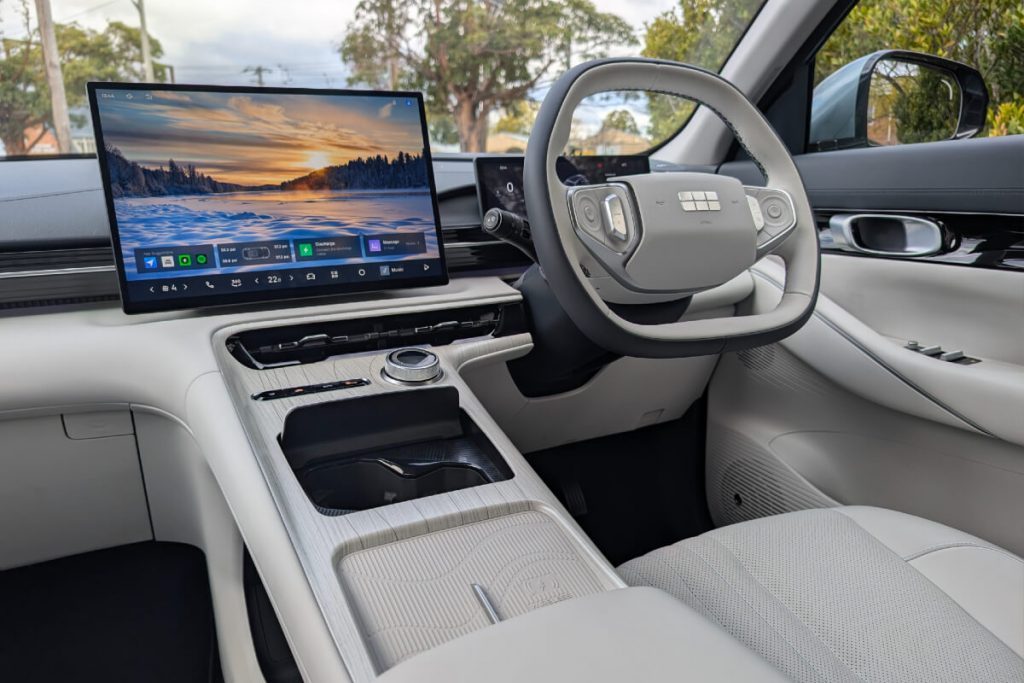
What’s it cost?
The price is right. In fact, it’s almost irresistible.
EX5 comes in two grades, Complete and Inspire, from a razor-sharp $40,990.
Our test vehicle, the better equipped Inspire, is priced from just $44,990 – both figures before on-road costs.
Standard equipment includes GeeLuxe perforated artificial leather trim and energy-saving, heat pump style, single climate control with rear air outlets.
In the Inspire the front seats are power-adjustable, as well as heated and cooled, with massage for the driver and an extendable leg rest for the front passenger.
Surprisingly, though, there’s no heated steering wheel.
The front seats also fully recline which means you can grab a ‘power’ nap while charging the car.
Privacy glass is standard while Inspire adds 256-colour ambient interior lighting.
There’s also pop-out door handles, walk-away locking, LED lighting for everything, driver head-up display, automatic high bream, auto-dimming rear-view mirror, auto lights and wipers, front and rear parking sensors and a 360-degree overhead camera.
Inspire also gets a power tailgate and a large power-operated sunroof.
Infotainment consists of a 15.4-inch touchscreen, with Bluetooth, voice assistant, Wi-Fi hotspot, FM/DAB+ digital radio (no AM) and built-in satellite navigation.
Apple CarPlay and Android Auto are still in the pipeline (more on this later).
Complete gets six-speaker audio; Inspire takes it to a whole new level with a Flyme (in-house brand) 1000 watt, 16-speaker system.
The sound is immersive and incorporates a basic sound equaliser, but could do with some quick presets for the various genres. Nothing like overkill!
There’s a wireless charge pad in front along with USB-A and -C ports front and back, as well as a 12-volt outlet in the front console.
EX5 gets a five-star safety rating, with seven airbags including a centre airbag which provides added protection for front seat occupants in side impact crashes.
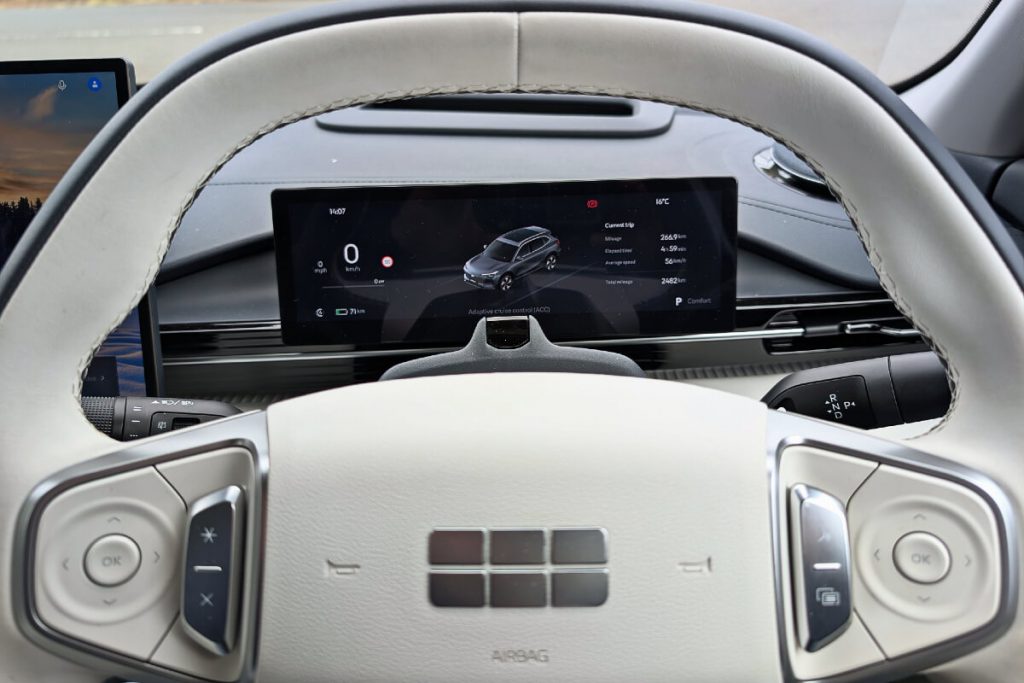
Autonomous emergency braking (Car-to-Car, Vulnerable Road User, Junction & Crossing, Backover and Head-On) as well as a lane support system with lane keep assist (LKA), lane departure warning (LDW) and emergency lane keeping (ELK), and an advanced speed assistance system (SAS) are standard.
There are ISOFix child seat anchors for the outer rear seats and three top tether points, plus a low-speed alert to warn pedestrians of the car’s approach.
EX5 is covered by a seven-year unlimited kilometre warranty, eight-year EV battery warranty, seven-year roadside assistance and two years of connected services with a built-in 4G sim that offers up to 2 gigs of data per month.

What’s it go like?
There’s a certain sameness to electric vehicles, regardless of brand.
They feel a bit like a golf buggy the way they just go when you press the accelerator.
That’s an oversimplification, but a good starting point for understanding the EV experience.
EX5 is the first vehicle to be built on Geely’s Global Intelligent New Energy Architecture (GEA) platform.
The five-seat crossover is 4515mm long and 1901mm wide, sits 1670mm high and has a 2750mm wheelbase (distance between axles).
To give this some perspective, RAV4 is 4600mm long, 1855mm wide and 1685mm high, with a 2690mm wheelbase (but has a larger boot).
EX5’s fit and finish are impressive and the cabin has a premium feel.
There’s a flat floor, plenty of rear legroom and a small but useful 302/410 litre luggage area that conceals a surprisingly large under floor storage – but alas, no spare wheel.
Suspension is by MacPherson strut front and a multi-link setup at the rear, with vented front discs and regenerative braking that can be manually adjusted via the menu system.
Complete rides on 18-inch alloys, the Inspire on 19s with 235/50 Goodyear rubber – a tyre repair kit is supplied in the event of a puncture.
The lithium-iron phosphate (LFP) battery pack is 60.22kWh in size and located under the floor.
It supplies a single electric motor that drives the front wheels through an automatic, one-speed reduction gearbox.
With 160kW of power and 320Nm of torque the dash from to 100km/h takes 7.1 seconds in Inspire, with a top speed that is limited to 175km/h.
There are three drive modes – Eco, Comfort and Sport – but to select one you need to visit the touchscreen.
The system defaults to Comfort, whereas most EV drivers will be looking for Eco mode to maximise range.
You can also adjust brake and steering feel, again via the menus.
Geely has adopted a minimalist approach to the design of the interior.
This means a large, central 15.4-inch touchscreen that controls just about everything, with few physical controls and a lack of labels.
The thing is that spending time digging through menus takes the driver’s eyes away from the road – that’s not good.
With no guide, working out what does what is a journey of discovery, one that can be frustrating and often time consuming.
The touchscreen can require several taps and there’s no Apple CarPlay or Android Auto, either wired or unwired.
They’re still on the way and expected to be introduced in the first quarter of 2026 via an over-the air update.
There is however built-in navigation and Geely’s version of smart phone mirroring called CarbitLink, together with a Geely app that can be downloaded – both forgettable.
Thankfully, there are physical controls for air and audio volume, although cranking up the call volume requires a ludicrous number of turns.
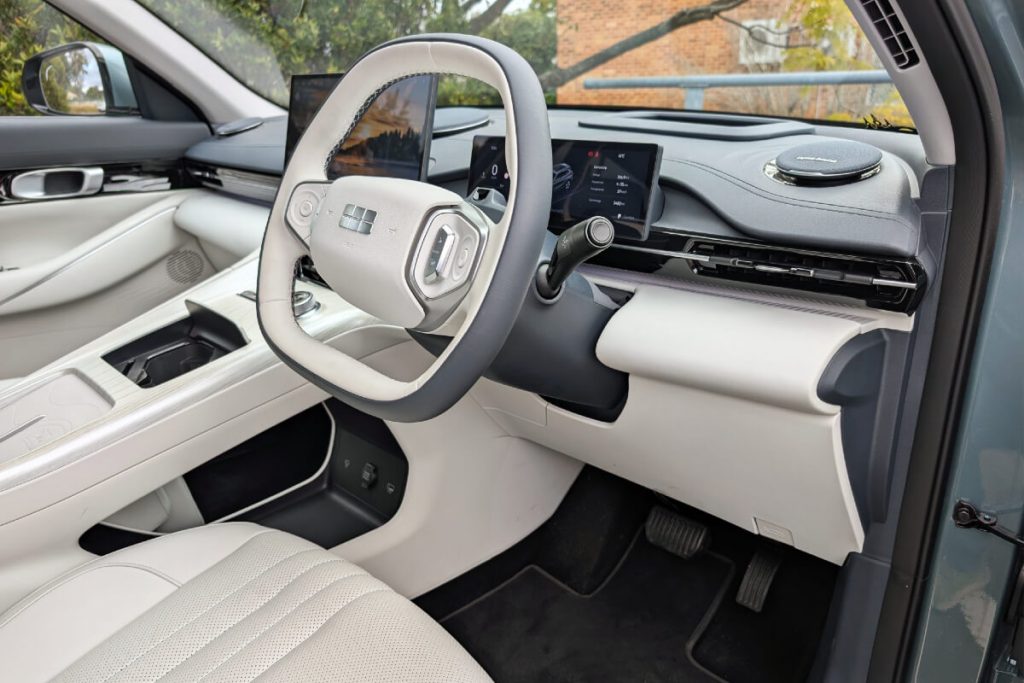
Speaking of controls, two identical circular clusters sit either side of the steering wheel with a central OK button and up and down arrows at either side.
There are no labels and it was only by trial and error that we were able to work out how to engage cruise control. How is this intuitive?
Along with these, there are two rectangular buttons: the right offers voice control and enables selection of different info pages for display in the instrument panel.
The left… well, we’re not exactly sure what it’s for, other than favourites – but it’s anyone’s guess how to set them up.
A long press on the top button opened the tailgate. The only way we could find to close it again was to get out and do it ourselves.
The key fob has an icon for the tailgate, but it does nothing.
Controls for the large sunroof are buried deep within the menu system.
Inspire consumes energy at the rate of 16.6kWh/100km and has a claimed range of 410km. However, the trip computer never displayed anything like this figure. The best we saw was 365km after three separate charging sessions.
The location of the charge port on the driver side front guard is more convenient than at the rear.
Based on 400-volt architecture, AC charging is possible at a maximum rate of 11kW and DC at 100kW.
With a fast 100kW+ commercial DC charger, Geely claims you can add 30 to 80 percent charge in just 20 minutes.
Why 30 to 80? Why not 0 to 50, or 50 to 100 percent perhaps? Well, fully charging an EV with a DC charger is apt to reduce battery life.
On the other hand, 30-80 percent is the range where charging will most likely occur fastest – before or after this the system is either speeding up or slowing down.
This is not the case with AC charging and a three-phase 11kW charger takes 5.7 hours to charge from zero to 100 percent.
As a last resort, the 10A charge cable supplied with the car takes up to 25 hours (a Mode 2 fast charge cable is $269.50).
EX5 also supports V2V connections which, if you’re feeling generous, means you could help out a stranded EV with a flat battery – if you had the right cable of course (that’s $209).
We clocked up 567km in our week behind the wheel of the EX5.
Rated at 16.6 kWh/100km, the trip computer indicated a long-term average of 15.6 kWh.
For the price the EX5 is an impressive bit of kit.
It might not handle like a sports car, but then it’s not supposed to.
It does however accelerate like one, especially with Sport mode selected.
But before heading off, take some time to familiarise yourself with some of the car’s idiosyncrasies.
For starters, there is no start button. Just put your foot on the brake, engage Drive, and you’re good to go.
Likewise, the parking procedure is a bit different, with a button on the end of the selector to put it into park.
The car however doesn’t actually switch off until you walk away – and vice-versa.
The gear selector by the way is mounted on the right of the steering column. This can lead to confusion, reaching for the gear shift instead of the indicators – luckily nothing cataclysmic occurs.
Acceleration is brisk, with impressive response off the line, but less so when it comes to roll on acceleration in the mid-range.
After this, the car quickly runs out of puff – and you’ll quickly run out of charge if you persist. Nothing sucks the life out of the battery like a high-speed run down the motorway.
Ride and handling are middle-of-the-road in keeping with the target buyer group, while braking can be abrupt until you get the knack of it.
You get used to these things, but one thing that never grows old is the continual, annoying barrage of beeps and warnings that will soon have you screaming “enough!”
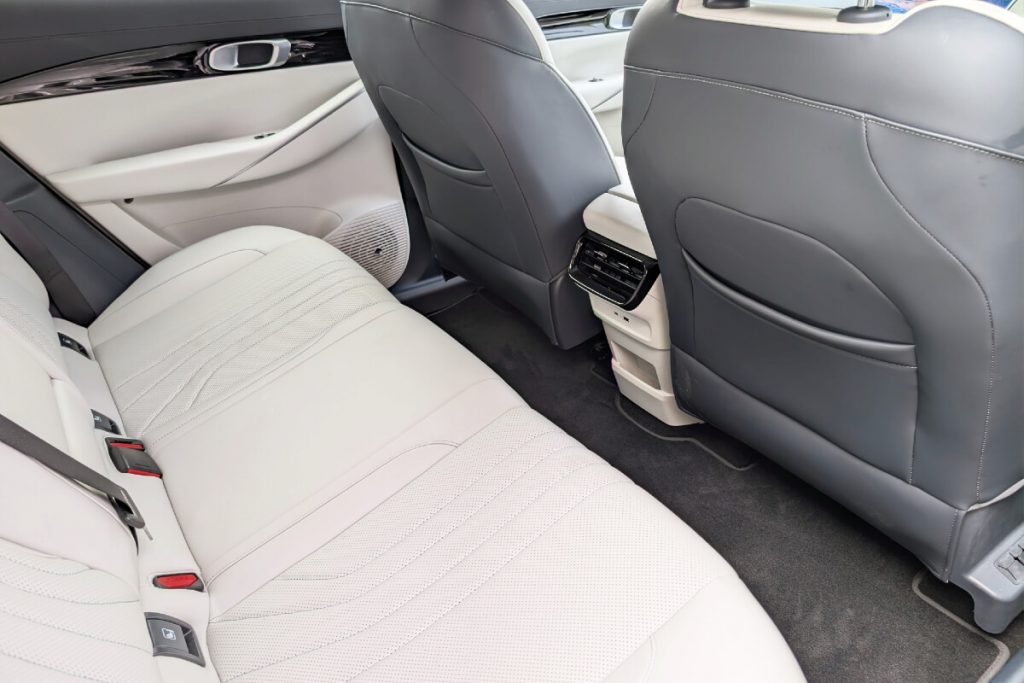
What we like
- Great price
- Comfortable
- Well equipped
- Easy to drive
What we don’t like
- Needs more range
- Controls need explanation
- Aircon slow to respond
- No AM radio (emergency broadcasts)
- No Apple CarPlay or Android Auto yet
- Comes with only a granny 10A charge cable
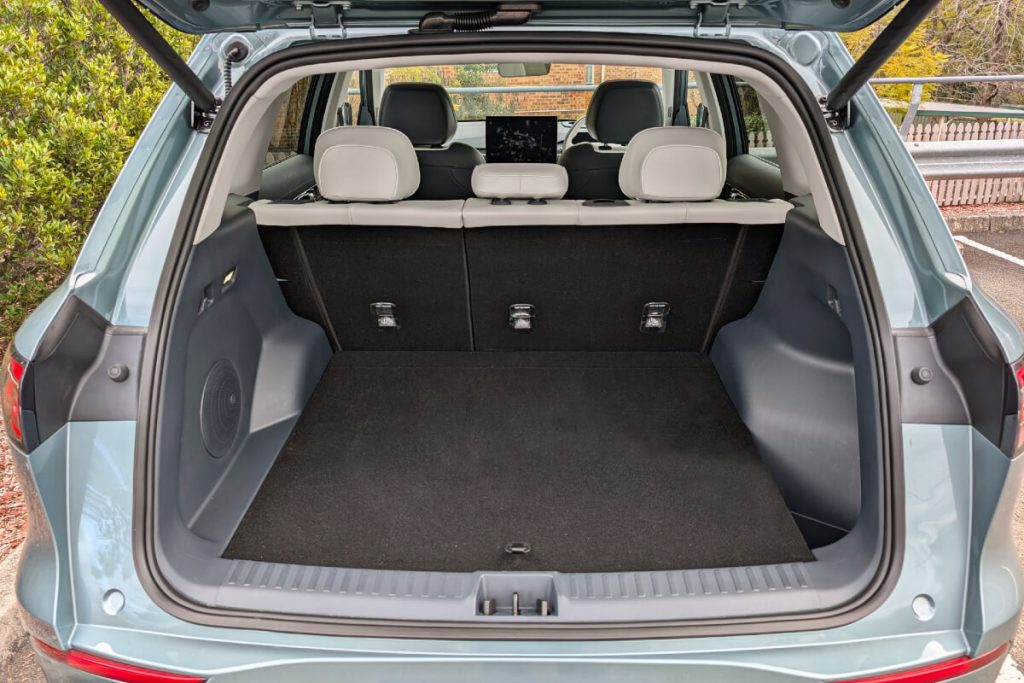
What over-50s need to know
For all you electric fence sitters, the Geely EX5 could be the one.
As a fully-electric vehicle, it offers excellent value for money and all of the practicalities of a small SUV that we’ve come to expect.
We’d feel more comfortable with a bit more range and some explanation of what the various controls do.
And we’re not sure what the hold-up is with CarPlay and Android Auto (at this late stage of the game).
But other than that, you could do a lot worse if you’re looking for an EV.

seniordriver comments
Every week seems to bring a new (and unknown to us) Chinese brand. Geely, as Chris points out, has been in Australia before, but it was a less-than-stellar arrival and most people will never have heard of the company.
The thing is, Geely is a real player in the market, and that may go some way to reducing the very understandable concern that some of these names may not be around in a few years’ time, and provide support.
As with most Chinese vehicles, price is going to make a strong argument for the Geely EX5, with an added incentive of a very well-equipped features list, a healthy long-term warranty and a reassuring five-star ANCAP rating.
Once again, we’re left in the dark as to what the connected services will cost once the initial complimentary two years runs out.
The similarity in dimensions to the Toyota RAV4 is no coincidence, and Toyota is sure to be watching closely how the Geely sells. Sure, you can buy a RAV4 for under $40,000 (before on road costs), but it’s two-wheel drive, and when you compare like-for-like, the price just doesn’t measure up to the Geely.
Some buyers will be tempted to wait until 2026 when Apple CarPlay and Android Auto will be offered, but with an over-the-air update planned, there really is no reason to hold off.
Annoying quirks like a tailgate that couldn’t be closed remotely may have been unique to the press car, but we’re not so sure. And we also aren’t sure about just having to engage Drive in order to take off, and the car not switching off until you walk away. If could take some getting used to.
As we are finding more often, the claimed range of 410km was never replicated on the in-car computer. Let’s face it, 365km falls a long way short. And then you have to factor in only charging the battery to 80 percent, and starting to stress when your charge falls below 20 percent. A range of 410km is pure fantasy.
